TOYOTA C-HR 2022 Owners Manual
Manufacturer: TOYOTA, Model Year: 2022, Model line: C-HR, Model: TOYOTA C-HR 2022Pages: 818, PDF Size: 113.75 MB
Page 471 of 818

469
4
4-5. Using the driving support systems
Driving
C-HR_HV_OM_Europe_OM10720E
RCTA (Rear Crossing Traffic Aler t)
The RCTA function uses the BSM rear side radar sensors installed
behind the rear bumper. This function is intended to assist the driver
in checking areas that are not easily visible when backing up.
Outside rear view mirror indicators
When a vehicle approaching from the right or left at the rear o f the vehicle
is detected, both outside rear view mirror indicators flash.
RCTA buzzer
If a vehicle approaching from the right or left at the rear of the vehicle is
detected, a buzzer will sound. The buzzer also sounds for appro ximately
1 second immediately after the RCTA function is turned on.
“RCTA OFF” indicator
Illuminates when the Rear Cross ing Traffic Alert is disabled.
: If equipped
Summary of the Rear Crossing Traffic Alert
Page 472 of 818
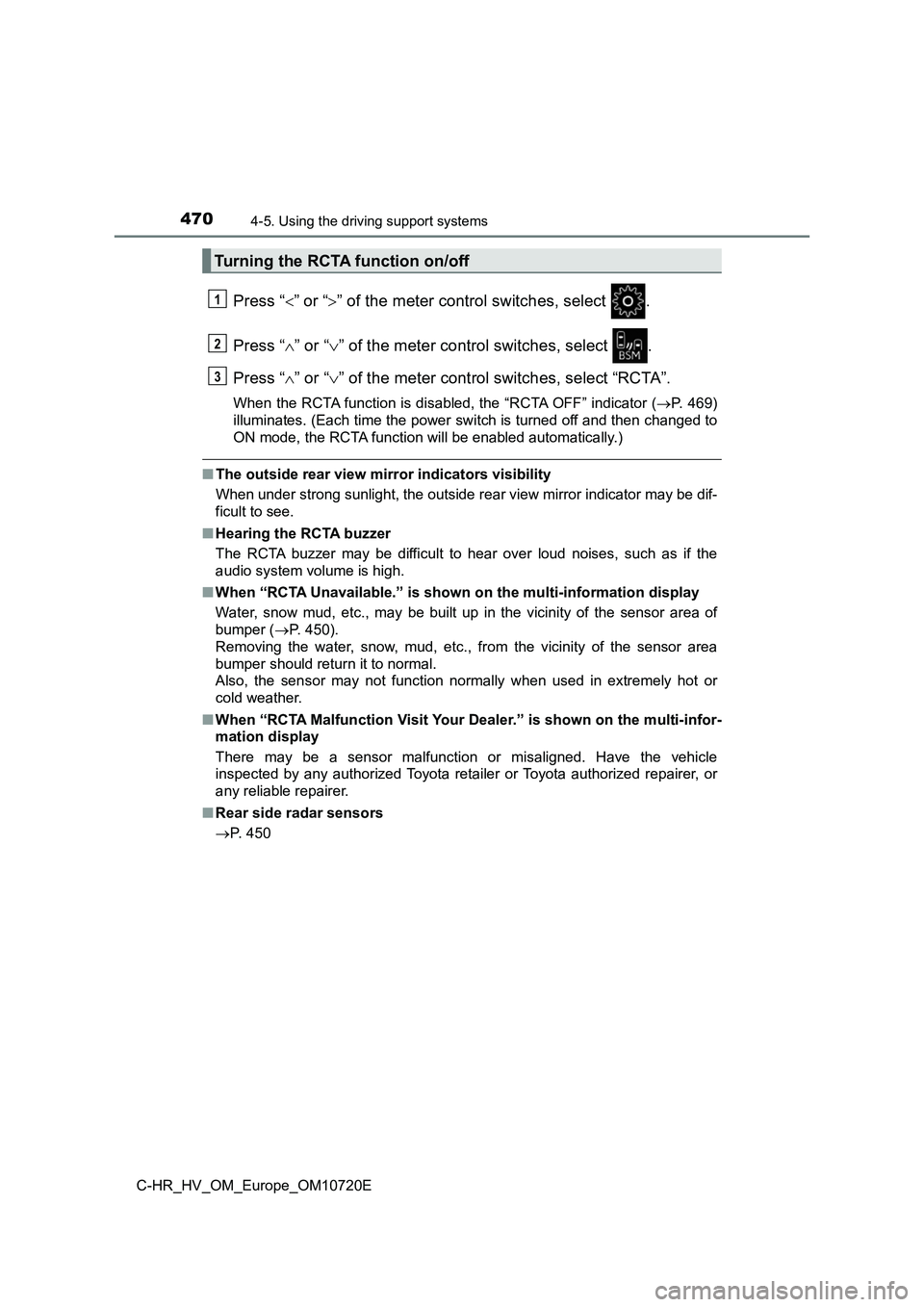
4704-5. Using the driving support systems
C-HR_HV_OM_Europe_OM10720E
Press “” or “” of the meter control switches, select .
Press “ ” or “” of the meter control switches, select .
Press “ ” or “” of the meter control switches, select “RCTA”.
When the RCTA function is disabled, the “RCTA OFF” indicator (P. 469)
illuminates. (Each time the power switch is turned off and then changed to
ON mode, the RCTA function will be enabled automatically.)
■ The outside rear view mirror indicators visibility
When under strong sunlight, the out side rear view mirror indicator may be dif-
ficult to see.
■ Hearing the RCTA buzzer
The RCTA buzzer may be difficult to hear over loud noises, such as if the
audio system volume is high.
■ When “RCTA Unavailable.” is shown on the multi-information display
Water, snow mud, etc., may be built up in the vicinity of the s ensor area of
bumper ( P. 450).
Removing the water, snow, mud, etc., from the vicinity of the s ensor area
bumper should return it to normal.
Also, the sensor may not function normally when used in extreme ly hot or
cold weather.
■ When “RCTA Malfunction Visit Your Dealer.” is shown on the multi-infor-
mation display
There may be a sensor malfunction or misaligned. Have the vehic le
inspected by any authorized Toyota retailer or Toyota authorize d repairer, or
any reliable repairer.
■ Rear side radar sensors
P. 450
Turning the RCTA function on/off
1
2
3
Page 473 of 818
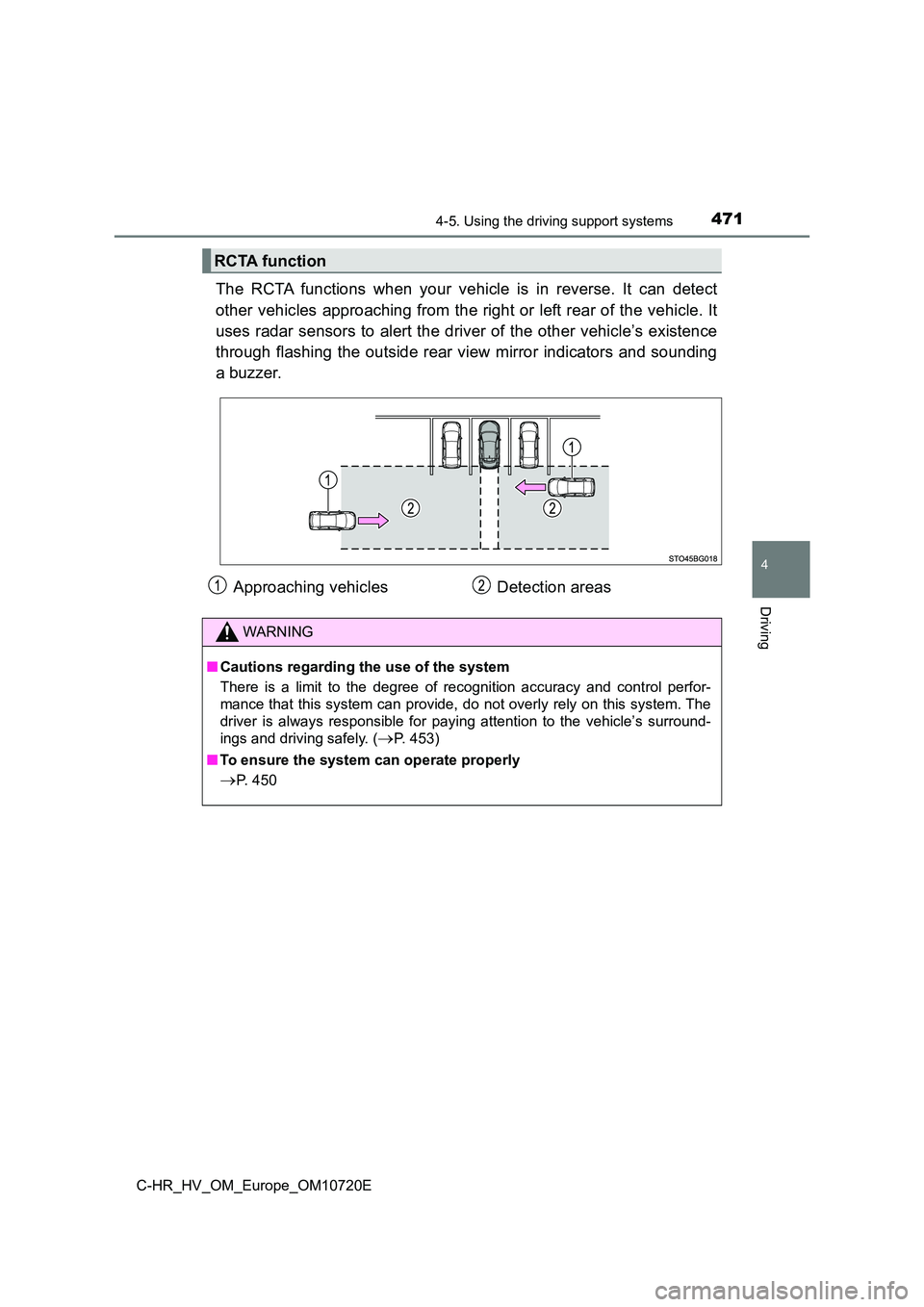
4714-5. Using the driving support systems
4
Driving
C-HR_HV_OM_Europe_OM10720E
The RCTA functions when your vehicle is in reverse. It can detect
other vehicles approaching from the right or left rear of the v ehicle. It
uses radar sensors to alert the driver of the other vehicle’s e xistence
through flashing the outside rear view mirror indicators and so unding
a buzzer.
RCTA function
Approaching vehicles Detection areas
WARNING
■ Cautions regarding the use of the system
There is a limit to the degree of recognition accuracy and cont rol perfor-
mance that this system can provide, do not overly rely on this system. The
driver is always responsible for paying attention to the vehicl e’s surround-
ings and driving safely. (P. 453)
■ To ensure the system can operate properly
P. 450
Page 474 of 818
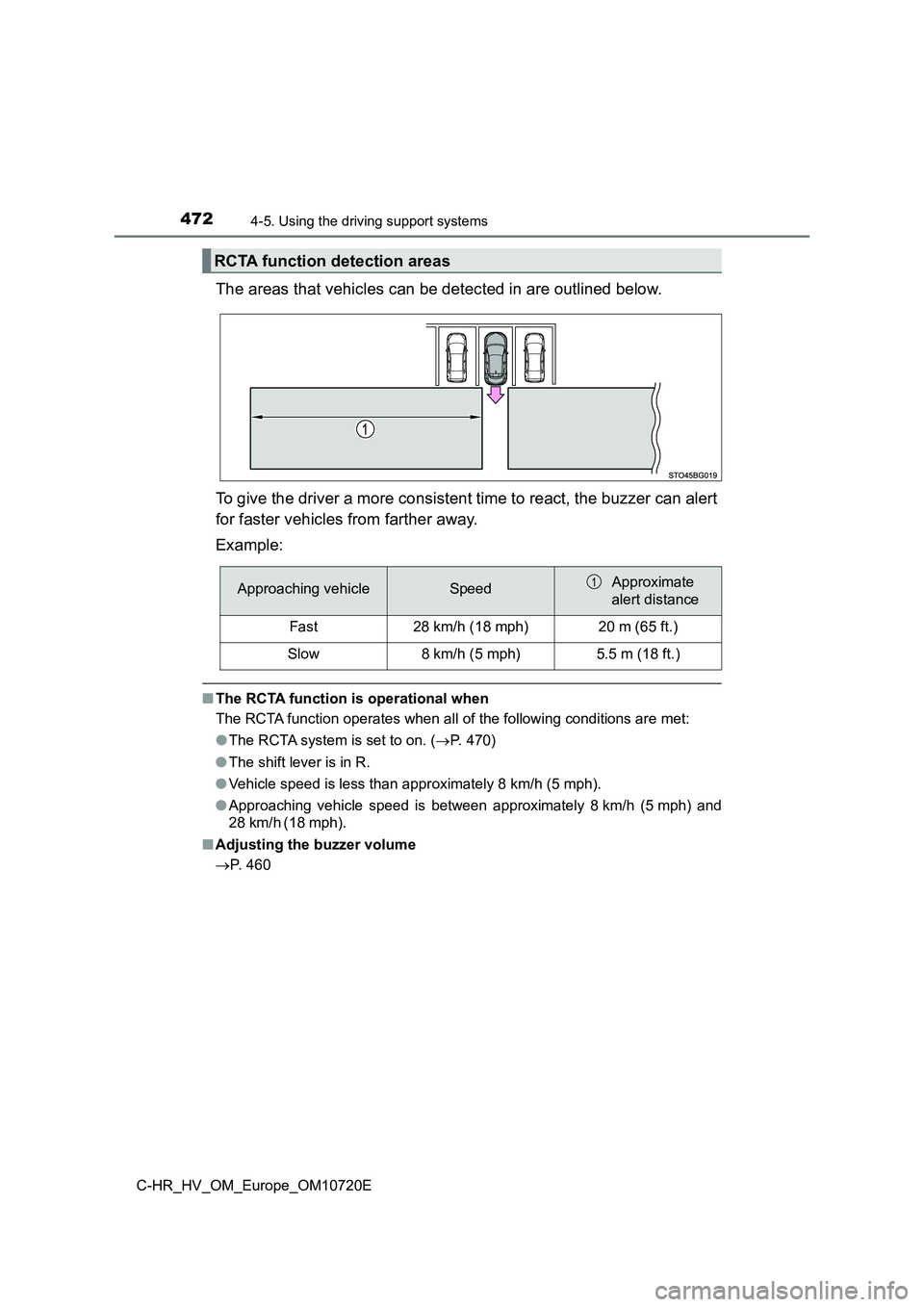
4724-5. Using the driving support systems
C-HR_HV_OM_Europe_OM10720E
The areas that vehicles can be detected in are outlined below.
To give the driver a more consistent time to react, the buzzer can alert
for faster vehicles from farther away.
Example:
■ The RCTA function is operational when
The RCTA function operates when all of the following conditions are met:
● The RCTA system is set to on. (P. 470)
● The shift lever is in R.
● Vehicle speed is less than approximately 8 km/h (5 mph).
● Approaching vehicle speed is between approximately 8 km/h (5 mph) and
28 km/h (18 mph).
■ Adjusting the buzzer volume
P. 460
RCTA function detection areas
Approaching vehicleSpeedApproximate
alert distance
Fast28 km/h (18 mph)20 m (65 ft.)
Slow8 km/h (5 mph)5.5 m (18 ft.)
Page 475 of 818
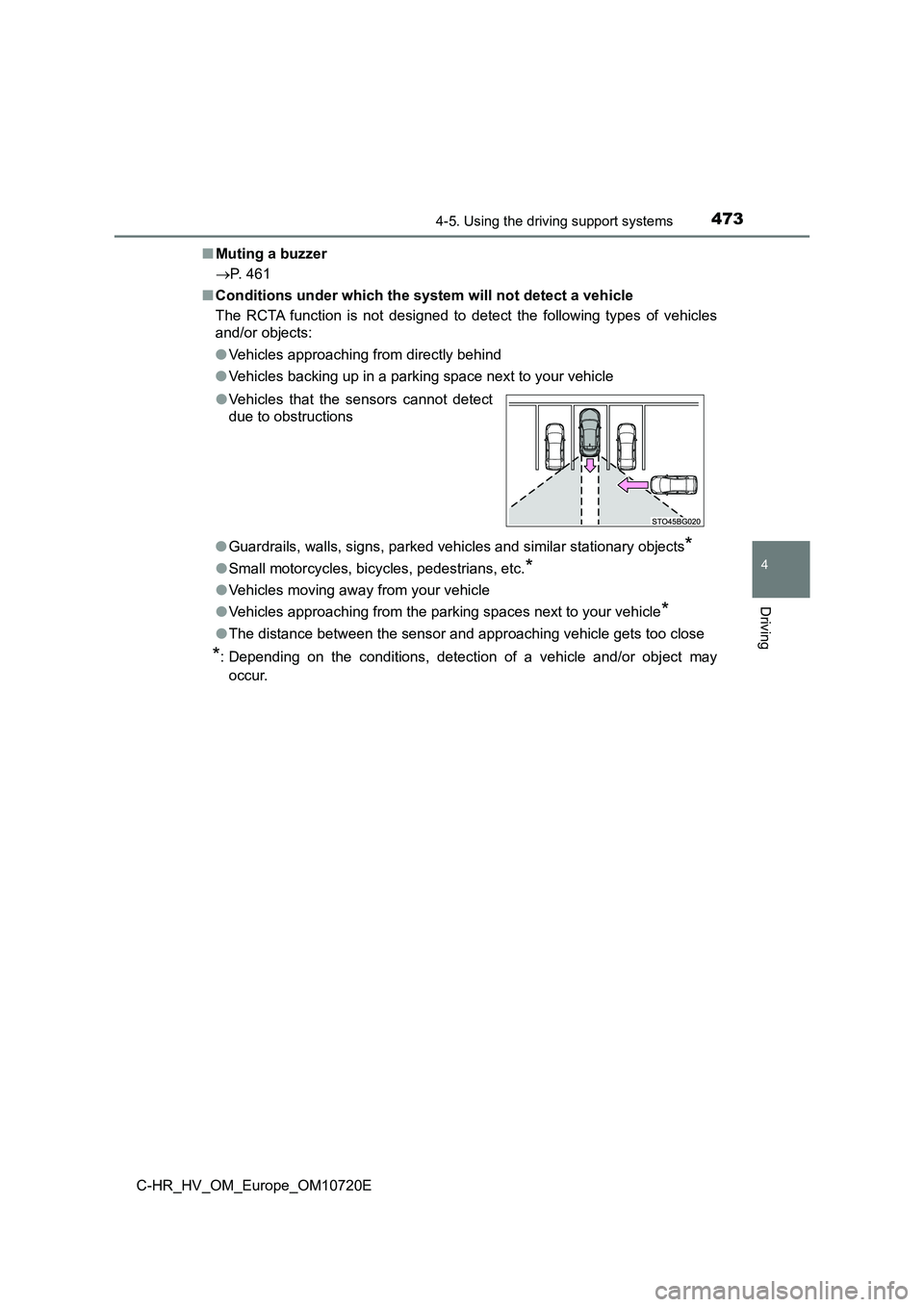
4734-5. Using the driving support systems
4
Driving
C-HR_HV_OM_Europe_OM10720E
■ Muting a buzzer
P. 461
■ Conditions under which the system will not detect a vehicle
The RCTA function is not designed to detect the following types of vehicles
and/or objects:
● Vehicles approaching from directly behind
● Vehicles backing up in a parking space next to your vehicle
● Guardrails, walls, signs, parked vehicles and similar stationary objects*
●Small motorcycles, bicycles, pedestrians, etc.*
●Vehicles moving away from your vehicle
● Vehicles approaching from the parking spaces next to your vehicle*
●The distance between the sensor and approaching vehicle gets too close
*: Depending on the conditions, detection of a vehicle and/or object may
occur.
● Vehicles that the sensors cannot detect
due to obstructions
Page 476 of 818
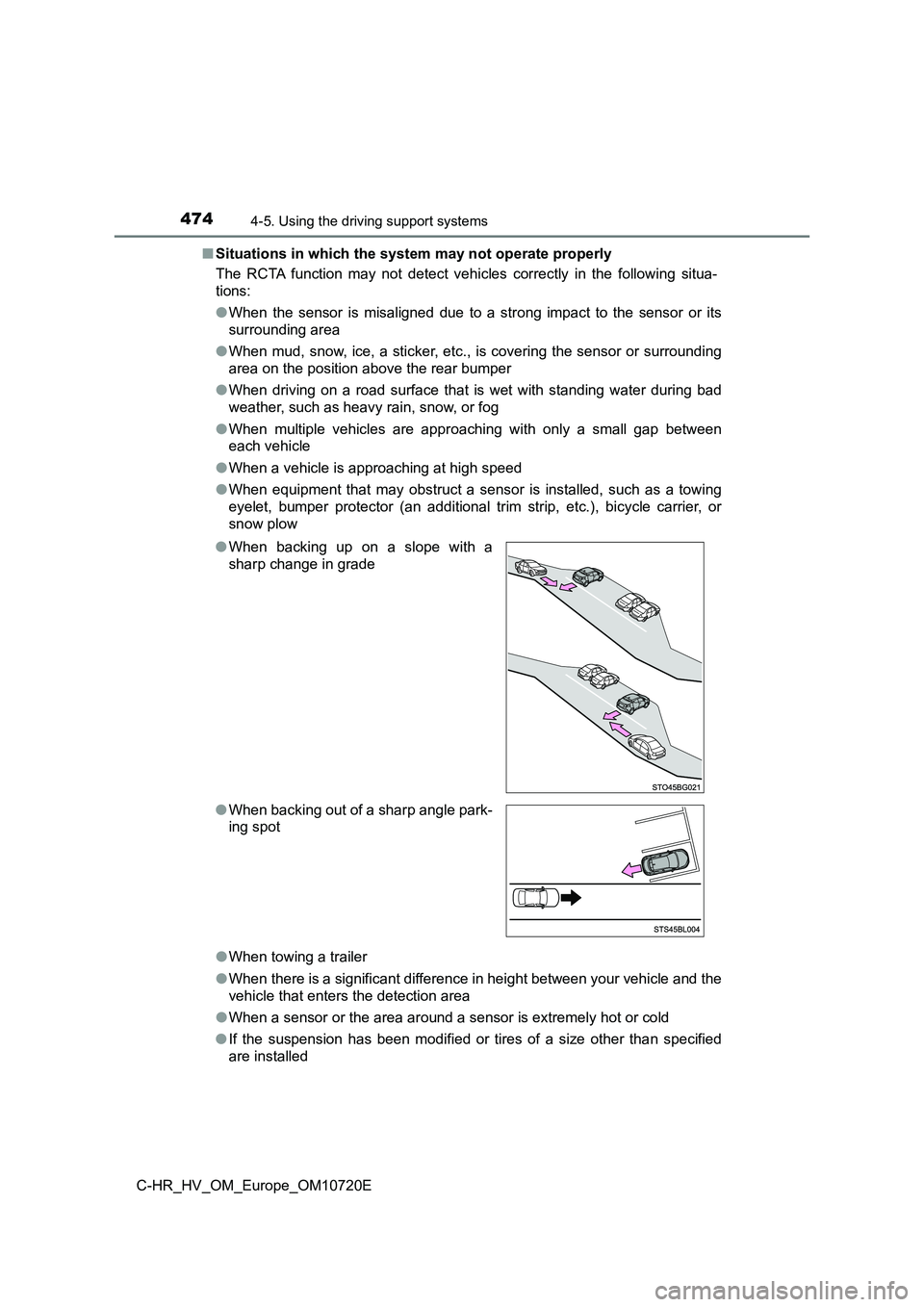
4744-5. Using the driving support systems
C-HR_HV_OM_Europe_OM10720E
■ Situations in which the system may not operate properly
The RCTA function may not detect vehicles correctly in the foll owing situa-
tions:
● When the sensor is misaligned due to a strong impact to the sensor or its
surrounding area
● When mud, snow, ice, a sticker, etc., is covering the sensor or surrounding
area on the position above the rear bumper
● When driving on a road surface that is wet with standing water during bad
weather, such as heavy rain, snow, or fog
● When multiple vehicles are approaching with only a small gap between
each vehicle
● When a vehicle is approaching at high speed
● When equipment that may obstruct a sensor is installed, such as a towing
eyelet, bumper protector (an additional trim strip, etc.), bicy cle carrier, or
snow plow
● When towing a trailer
● When there is a significant difference in height between your vehicle and the
vehicle that enters the detection area
● When a sensor or the area around a sensor is extremely hot or cold
● If the suspension has been modified or tires of a size other than specified
are installed
● When backing up on a slope with a
sharp change in grade
● When backing out of a sharp angle park-
ing spot
Page 477 of 818

4754-5. Using the driving support systems
4
Driving
C-HR_HV_OM_Europe_OM10720E
● If the front of the vehicle is raised or lowered due to the carried load
■ Situations in which the system may operate even if there is no possibil-
ity of a collision
Instances of the RCTA function unnecessary detecting a vehicle and/or object
may increase in the following situations:
● When equipment that may obstruct a sensor is installed, such as a towing
eyelet, bumper protector (an additional trim strip, etc.), bicy cle carrier, or
snow plow
● When turning while backing up
● When a vehicle turns into the detection
area
● When the parking space faces a street
and vehicles are being driven on the
street
● When the distance between your vehicle
and metal objects, such as a guardrail,
wall, sigh, or parked vehicle, which may
reflect electrical waves toward the rear
of the vehicle, is short
Page 478 of 818
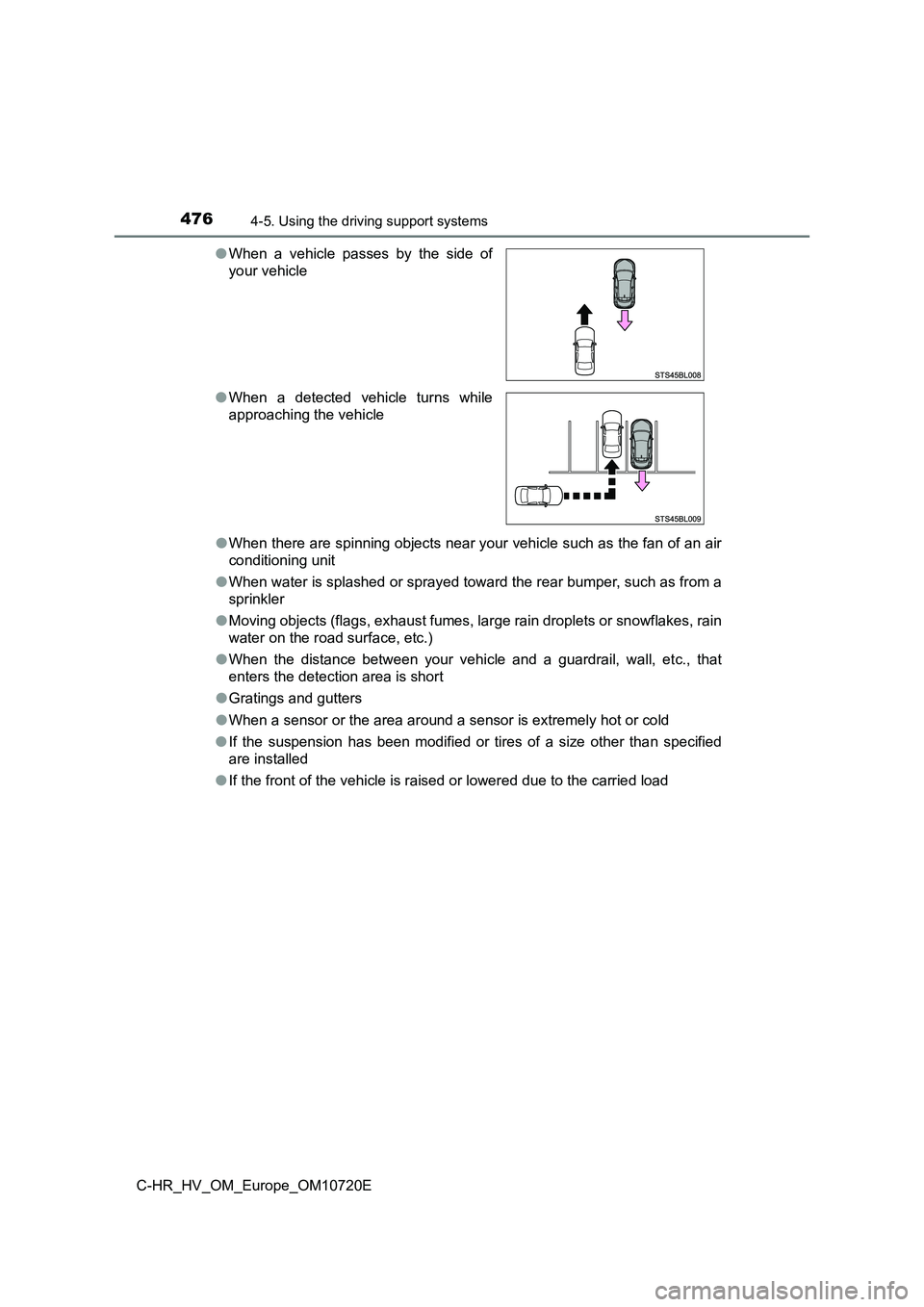
4764-5. Using the driving support systems
C-HR_HV_OM_Europe_OM10720E
● When there are spinning objects near your vehicle such as the fan of an air
conditioning unit
● When water is splashed or sprayed toward the rear bumper, such as from a
sprinkler
● Moving objects (flags, exhaust fumes, large rain droplets or snowflakes, rain
water on the road surface, etc.)
● When the distance between your vehicle and a guardrail, wall, etc., that
enters the detection area is short
● Gratings and gutters
● When a sensor or the area around a sensor is extremely hot or cold
● If the suspension has been modified or tires of a size other than specified
are installed
● If the front of the vehicle is raised or lowered due to the carried load
● When a vehicle passes by the side of
your vehicle
● When a detected vehicle turns while
approaching the vehicle
Page 479 of 818
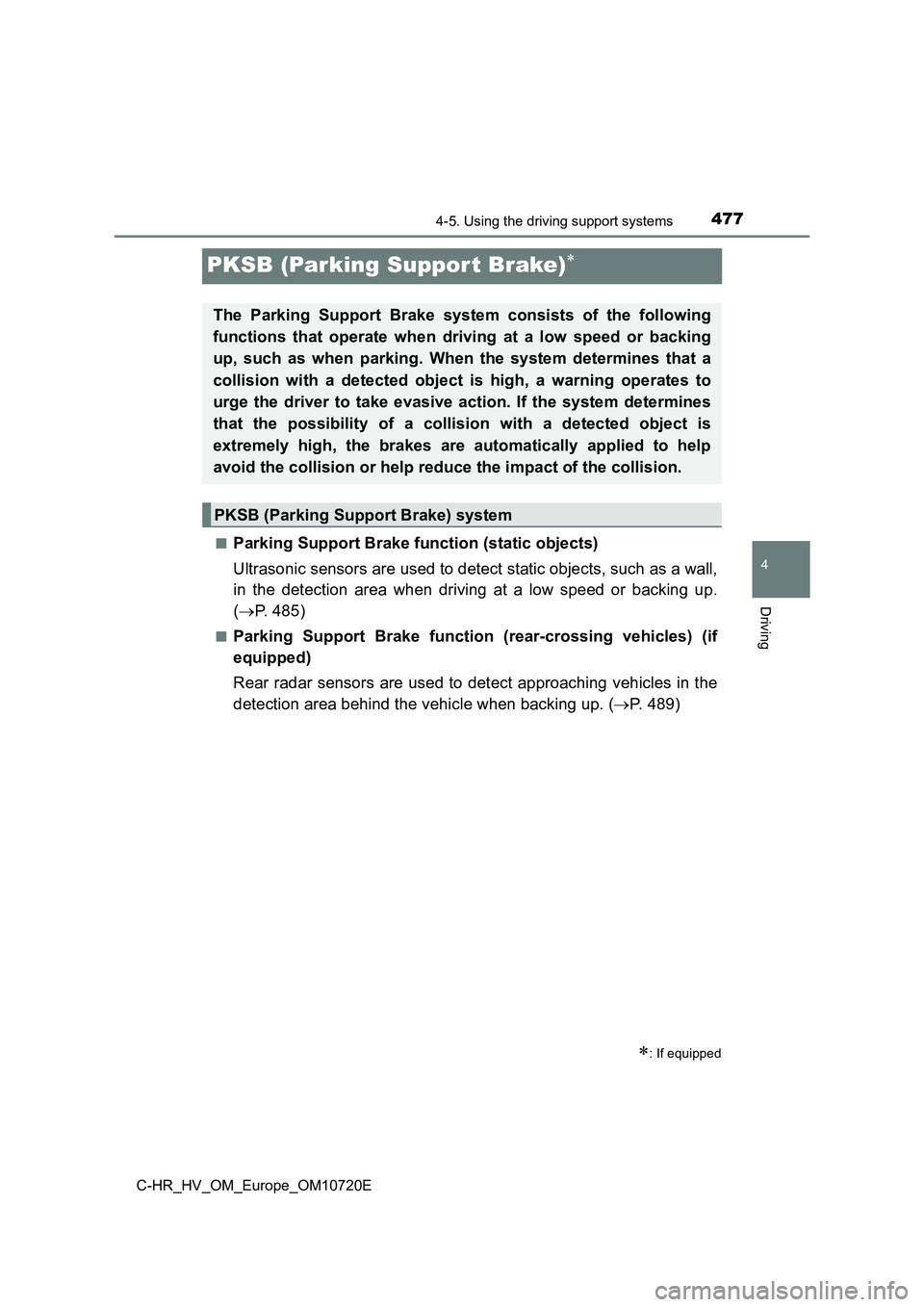
477
4
4-5. Using the driving support systems
Driving
C-HR_HV_OM_Europe_OM10720E
PKSB (Parking Suppor t Brake)
■Parking Support Brake function (static objects)
Ultrasonic sensors are used to detect static objects, such as a wall,
in the detection area when driving at a low speed or backing up .
( P. 485)
■Parking Support Brake function (rear-crossing vehicles) (if
equipped)
Rear radar sensors are used to detect approaching vehicles in t he
detection area behind the vehicle when backing up. ( P. 4 8 9 )
: If equipped
The Parking Support Brake system consists of the following
functions that operate when driving at a low speed or backing
up, such as when parking. When the system determines that a
collision with a detected object is high, a warning operates to
urge the driver to take evasive action. If the system determine s
that the possibility of a collision with a detected object is
extremely high, the brakes are automatically applied to help
avoid the collision or help reduce the impact of the collision.
PKSB (Parking Support Brake) system
Page 480 of 818
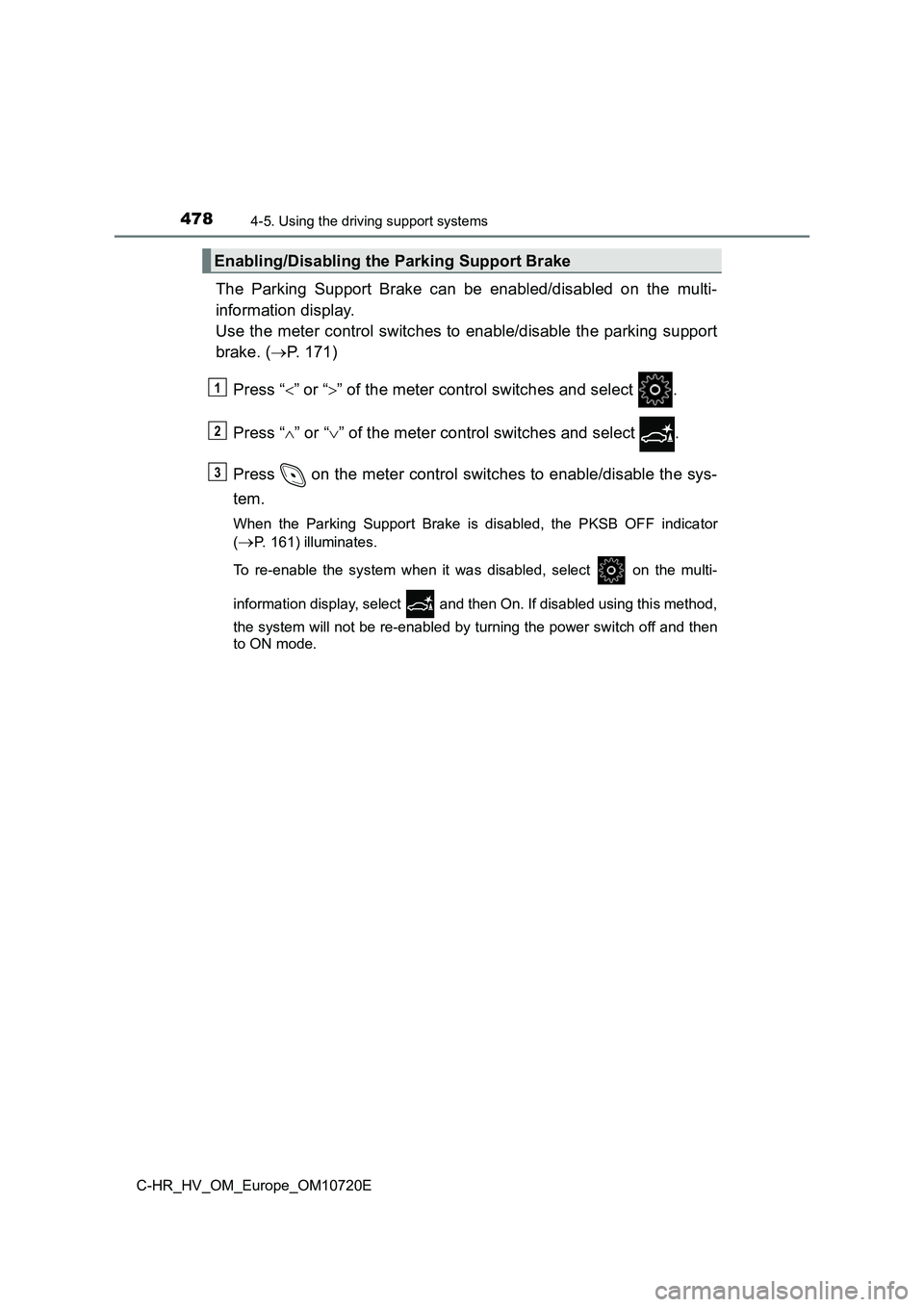
4784-5. Using the driving support systems
C-HR_HV_OM_Europe_OM10720E
The Parking Support Brake can be enabled/disabled on the multi-
information display.
Use the meter control switches to enable/disable the parking su pport
brake. ( P. 171)
Press “ ” or “” of the meter control switches and select .
Press “ ” or “” of the meter control switches and select .
Press on the meter control switches to enable/disable the sys-
tem.
When the Parking Support Brake is disabled, the PKSB OFF indica tor
(P. 161) illuminates.
To re-enable the system when it was disabled, select on the mu lti-
information display, select and then On. If disabled using thi s method,
the system will not be re-enabled by turning the power switch o ff and then
to ON mode.
Enabling/Disabling the Parking Support Brake
1
2
3